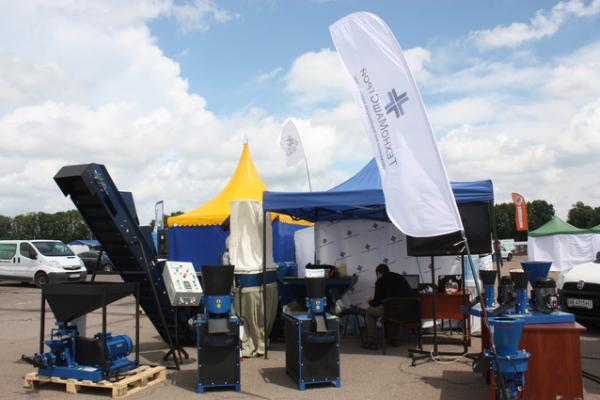Complete pellet manufacturing cycle

In the framework of this article, we will consider the main equipment that allows you to organize a closed production cycle. The main stages of production are: wood chopping, drainage (getting rid of excess moisture), granulation, fractional screening (sifting), cooling and transportation for subsequent packaging. We consider each stage individually.
Stage One - Grinding.
Includes wood chips and a hammer mill. It is noteworthy that this equipment successfully works with both dry and wet wood. The main function of the chip cutter is the preliminary cutting of the whole waste of the woodworking industry (slats, laths, slabs, branches) into technological chips. For the convenience of harvesting raw materials, the TekhnoMashStroy company’s chip cutters are made not only with an electric drive but also with its gasoline analogue or drive from the tractor’s PTO shaft. Thus, the procurement of raw materials can be carried out in any conditions, regardless of the presence of a connection to the power supply network.
Hammer crusher, in turn, allows crushing chips to small fibers. This allows you to automate the process of picking probes from an intermediate fluid or open space using a pneumatic (vacuum) feed of raw materials through a flexible sleeve. At the request of the client, this option can be complete. As part of the line, it is preferable to complete the hammer crusher with a cyclone.
Stage two - drainage (drying) of sawdust.
It is an integral part of the processing cycle, since in order to obtain high-quality granules, the humidity level should be 12-15%. The drying process is implemented as follows: the crushed sawdust comes from the hammer mill to the storage (loading hopper) of aerodynamic drying, from where it is transferred by the feed screw to the pipeline system. Next, the sawdust along with hot air moves through the pipeline to the cyclone. During the movement of hot air in the environment (which is taken out of the combustion chamber with a special fan), sawdust gives off excess moisture. The cyclone acts as a dehumidifier, directing the dried sawdust into the storage hopper installed directly in front of the granulator. Excess moisture is discharged through the ventilation duct at the top of the cyclone. You can familiarize yourself with the assortment of Aerodynamic dehumidifiers of the TechnoMashStroy company in the corresponding section.
The third stage is granulation.
The maximum efficiency of the sawdust granulation process is achieved only with a uniform feed of raw materials into the granulator hopper with loading on one third of the rollers. This level is easily provided by a special screw conveyor controlled by a frequency converter. It is he who will provide long life to the electric motor of your granulator (uniform feed = no overloads and overheating). Sawdust falling into the working area of the granulator is pressed by rollers into the holes of the matrix. Since the inlet of the hole has the shape of a cone, due to narrowing, the holes of the sawdust are compressed to the required density. Coming out of the holes of the matrix, the finished granule breaks off with special knives with adjustable height.
The fourth stage - screening and cooling
After the granulator, the granule enters the rotating drum calibrator. The screening grid of this drum has many holes, the diameter of which coincides with the diameter of the granules. This allows you to effectively sift out all non-granular particles and move them into a storage bag for subsequent processing. It should be noted that the role of this stage is not only in sieving, but also in cooling the granules, since the exhaust dust fan creates an effective directed flow of airflow. Thus, dual functionality is combined in one device.
The fifth stage is cooling and transportation to containers.
After the drum-calibrator of the cooler, the granule wakes up on a scraper-type conveyor belt. On this conveyor special boxes with fans are installed. The pellet moving along the conveyor belt falls into the zone of intensive airflow with high-speed fans. This ensures the most efficient cooling of the granules and, as a result, the absence of condensate on the walls of the container in which this granule will be transported. We remind you that a drop of condensate deposited on the wall of the container and in contact with the granule will destroy the latter and damage the presentation of the product. Therefore, we recommend that you pay special attention to this nuance if low temperatures are possible in your room in the winter.
We wish you success in working with quality equipment. If after reading this article you still have questions - contact the manager of the manufacturer and he will give you a detailed answer.

TechnoMashStroy was again represented at AGROSHOW Ukraine 2018, showing a wide range of products in the categories: Granulators, Granulation Lines, Extruders, Choppers and other biomass. On May 16-19, the international agro-industrial expo-festival ...